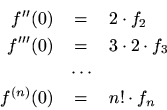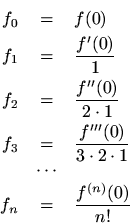NOTE: THIS DOCUMENT IS OBSOLETE, PLEASE CHECK THE NEW VERSION: "Mathematics of the Discrete Fourier Transform (DFT), with Audio Applications --- Second Edition", by Julius O. Smith III, W3K Publishing, 2007, ISBN 978-0-9745607-4-8. - Copyright © 2017-09-28 by Julius O. Smith III - Center for Computer Research in Music and Acoustics (CCRMA), Stanford University
<< Previous page TOC INDEX Next page >>
Informal Derivation of Taylor Series ExpansionWe have a function
and we want to approximate it using an
th-order polynomial:
where, which is obviously the approximation error, is called the ''remainder term.'' We may assume
and
are real, but the following derivation generalizes unchanged to the complex case.
Our problem is to find fixed constants
so as to obtain the best approximation possible. Let's proceed optimistically as though the approximation will be perfect, and assume
for all
(
), given the right values of
. Then at
we must have
That's one constant down andto go! Now let's look at the first derivative of
with respect to
, again assuming that
:
Evaluating this atgives
In the same way, we find
wheredenotes the
th derivative of
with respect to
, evaluated at
. Solving the above relations for the desired constants yields
Thus, defining(as it always is), we have derived the following polynomial approximation:
This is theth-order Taylor series expansion of
about the point
. Its derivation was quite simple. The hard part is showing that the approximation error (remainder term
) is small over a wide interval of
values. Another ''math job'' is to determine the conditions under which the approximation error approaches zero for all
as the order
goes to infinity. The main point to note here is that the form of the Taylor series expansion itself is simple to derive.


